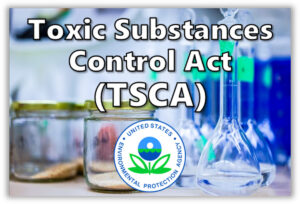Written on: September 1, 2021 by Nicholas Georges
When I first started in the household and commercial products industry, I had a simplistic view of the Toxic Substances Control Act (TSCA) and only cared if a substance was on the TSCA Inventory. From my perspective, TSCA was an issue for upstream suppliers, not something I had to bother with as a formulator.
In 2016, the Frank R. Lautenberg Chemical Safety for the 21st Century Acti amended TSCA and strengthened the U.S. Environmental Protection Agency’s (EPA) authority. Even with these amendments, many end-use product manufacturers continue to only be concerned with TSCA when a chemical they use comes under review. However, there’s a new proposed rule under TSCA that everyone needs to be aware of—formulators and end- use manufacturers included.

The National Defense Authorization Act for Fiscal Year 2020ii became public law on Dec. 20, 2019. While this law specified the annual budget and expenditures for the U.S. Dept. of Defense for fiscal year 2020, it also amended TSCA to add Section 8(a)(7), which mandates the EPA to promulgate a rule by Jan.1, 2023 that requires a broad range of companies that have manufactured a substance defined as per- and polyfluoroalkyl substances (PFAS) since Jan. 1, 2011 to retroactively report certain information.
To comply with this mandate from Congress, the EPA proposed a rule in June 2021 titled Toxic Substances Control Act Reporting & Recordkeeping Requirements for Perfluoroalkyl & Polyfluoroalkyl Substances.iii As currently proposed, the draft report’s requirements could impact many companies that don’t typically report under TSCA, since it applies to manufacturers and importers of PFAS chemicals, as well as byproduct formation of PFAS and manufacturers and importers of articles containing PFAS. Importantly, the proposal does not exclude small businesses, nor does it incorporate a volume reporting threshold in order to meet the requirements of TSCA section 8(a) added by Congress. The proposal contains exclusions for certain products, such as pesticides defined by the Federal Insecticide, Fungicide & Rodenticide Act (FIFRA) and food, food additives, drugs, cosmetics or devices defined by the Federal Food, Drug & Cosmetic Act.
It’s important to note that the proposed definition for PFAS within the rule includes per- and polyfluorinated substances that structurally contain the unit R-(CF2)-C(F)(R’)R”. The EPA has identified at least 1,364 chemical substances and mixtures that meet this definition and could be subject to the reporting requirement. The proposed rule will also include structural diagrams to capture any PFAS that was not included due to confidential business information (CBI) claims, meets the low-volume exemption (LVE) or is a byproduct and is not listed on the TSCA inventory but still meets the structural definition.
The proposal requires that manufacturers and importers report information “to the extent that the information is known to or reasonably ascertainable by them, or a reasonable estimate when actual data are not available.” To be clear, the proposal defines “known to or reasonably ascertainable by” as “all information in a person’s possession or control, plus all information that a reasonable person similarly situated might be expected to possess, control or know.”
As proposed, this rule will require significant communication within companies and throughout the supply chain to provide the requested information. The EPA has identified an incredibly large number of product categories—including in the consumer and commercial spaces—that manufacturers and importers will have to disclose if PFAS is present. If a product category doesn’t exist, there is a case for “Other” and a description of use must be included. The EPA is also requesting additional information be reported, such as production volume, disposal, exposure and hazard.
According to the proposal, the EPA intends to use all of this information to assist in chemical assessments under TSCA, and to inform any additional work necessary under environmental protection mandates beyond TSCA.
This rule makes it clear that TSCA isn’t just for chemical suppliers—it can have an impact on the entire supply chain. If you have questions about PFAS, retroactive reporting or TSCA in general, please contact me at ngeorges@thehcpa.org. SPRAY